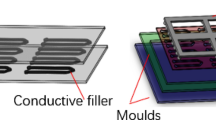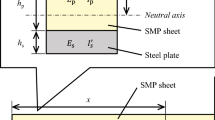Abstract
We consider flex (or bending) polymer-based soft sensor that measures its own bending in terms of electrical resistance. When it is used for precise positioning as a part of fast control feedback, e.g. in soft robotic manipulators, sensor measurements show hysteresis-like rate-dependent behaviour typical for viscoelastic materials. We have constructed a simple electromechanical device for its investigation.
Access provided by Autonomous University of Puebla. Download conference paper PDF
Similar content being viewed by others
1 Introduction
Various devices using resistive flex sensors [8] have been made available in different areas such as biometric measurements for medical purposes or interfacing virtual reality. Nevertheless, these are slow-motion, imprecise applications. The advancements in soft robotics [4, 11], where such sensors could be printed directly on a robot body or used in other capacity as a part of control feedback, pose a serious question about reliability of their readings. Since the sensors are made of polymers, it is natural to assume that the well-known viscoelastic behaviour of polymers (see, e.g. [2, 3, 10]), including rate-dependent hysteresis, can affect the sensor readings.
Nonlinear rate-dependent hysteresis was not extensively studied from the mathematical viewpoint, and so far only a few publications (see, e.g. [1]) are available on the subject. Well-known classical models of hysteresis, such as the Prandtl–Ishlinskii and Krasnoselskii–Pokrovskii model, do not incorporate rate dependence [7, 9]. Even the application of the term ‘hysteresis’ in a rate-dependent setting is questionable for some researchers in mathematics. It is therefore important to create a simple and cheap device to analyse such behaviour in a typical university environment without complex laboratory setup, to facilitate the development of its mathematical models.
The viscoelastic materials have a relationship between stress and strain that depends on time or frequency. In engineering, linear viscoelastic material models can be represented by an arbitrary composition of linear springs and dampers; see Fig. 1. The simplest model for solids that is able to show all phenomena related to viscoelasticity is the following three-parameter model (also called the standard linear solid or the Zener model, see, e.g. [10]):
where \(\sigma \) is stress, \(\varepsilon \) is strain, \(\eta \) is viscosity, \(E_0\) and \(E_1\) are Young’s modulus and the parameters of the relaxation function, respectively:
and \(\tau _R=\eta /E_1\) denotes the relaxation time. In the nonlinear case, no ‘standard’ model is available.
2 Experimental Results
In our experimental device, a small oval-shaped plastic arm is attached to an Arduino-controlled servomotor and is kinematically linked with the Flex Sensor® 4.5” available from Spectra Symbol, which is connected to the same Arduino module as the servomotor. Arduino is a popular robotics hobbyist platform, which can be also used for data acquisition in experiments. One side of the sensor is printed with a polymer ink that has conductive particles embedded in it. When the sensor is bent away from the ink, the conductive particles move further apart, increasing its resistance.
The positional servomotor SG90 can approximate a trajectory of its angular motion using a number of reference points. The delay before setting the next reference point is related to its angular speed (maximum is 500 deg/sec). Angular speed for the sensor tip is linearly related to the angular speed of the motor, which is six times higher.
This device (see Fig. 2) is a modification (simply the replacement of a fan with servomotor) of Flexy [5], initially created at the Slovak University of Technology in Bratislava for teaching students the basics of automatic control. Its electrical schemes and blueprints for laser cutting are freely available [6].
To test the hypothesis of sensor viscoelastic behaviour, we have conducted a number of experiments with different piecewise-linear angular inputs, see Fig. 3. In each case, we vary the sensor tip angle from 5 to 20 degrees (measured by a protractor). We divide the whole angle interval into 40 reference points and then vary the delay before setting a new reference point for the servo. As a result, with decreasing of the delay we have obtained different curves for loading (angle increasing) and unloading (angle decreasing), see Fig. 3. In the fastest case depicted in Fig. 4, a possible error in sensor readings can be as large as 60–70%.
As one can see, under slow angular motion (blue in Fig. 3) the hysteresis curve (also blue in Fig. 4) can cross itself. It is also not a loop: probably due to the viscosity of the sensor, it never returns exactly to the same reading as started, but it can get there after some time if unloaded. It appears that the hysteresis curve is asymmetrical and its width increases with increasing of the angular speed.
3 Conclusion
We have developed a simple electromechanical device based on freely available design, which can be used for investigation of rate-dependent viscoelastic hysteresis. At the present time, the results are inconclusive: the servomotor has no position feedback and cannot be used for correct system identification. Our future goal is to improve our device which, hopefully, can help in deriving mathematical model of the sensor.
References
R.S. Anderssen, I.G. Götz, K.H. Hoffmann, The global behavior of elastoplastic and viscoelastic materials with hysteresis-type state equations. SIAM J. Appl. Math. 58(2), 703–723 (1998)
H.T. Banks, A brief review of some approaches to hysteresis in viscoelastic polymers. Nonlinear Anal. 69(3), 807–815 (2008)
G. Bles, W.K. Nowacki, A. Tourabi, Experimental study of the cyclic visco-elasto-plastic behaviour of a polyamide fibre strap. Int. J. Solids Struct. 46, 2693–2705 (2009)
K. Elgeneidy, N. Lohse, M. Jackson, Bending angle prediction and control of soft pneumatic actuators with embedded flex sensors–a data-driven approach. Mechatronics 50, 234–247 (2018)
M. Kalúz, L. Čirka, M. Fikar, Flexy: an open-source device for control education, in 13th APCA International Conference on Control and Soft Computing (CONTROLO) (University of the Azores, 2018)
M. Kalúz, Flexy (2018) (preprint). https://www.uiam.sk/~kaluz/opensourceprojects/contents/flexy.html
M.A. Krasnosel’skii, A.V. Pokrovskii, Systems with Hysteresis (Springer, Berlin, 1989)
G. Saggio, F. Riillo, L. Sbernini, Quitadamo LR Resistive flex sensors: a survey. Smart Mater. Struct. 25, 1–30 (2016)
A. Visintin, Differential Models of Hysteresis (Springer, Berlin, 1994)
A.S. Wineman, K.R. Rajagopal, Mechanical Response of Polymers (Cambridge University Press, Cambridge, 2000)
J. Zhang, K. Iyer, A. Simeonov, M.C. Yip, Modeling and inverse compensation of hysteresis in supercoiled polymer artificial muscles. IEEE Robot. Autom. Lett. 2(2), 773–780 (2017)
Author information
Authors and Affiliations
Corresponding author
Editor information
Editors and Affiliations
Rights and permissions
Copyright information
© 2019 Springer Nature Switzerland AG
About this paper
Cite this paper
Demenkov, M. (2019). Experimental Investigation of Viscoelastic Hysteresis in a Flex Sensor. In: Korobeinikov, A., Caubergh, M., Lázaro, T., Sardanyés, J. (eds) Extended Abstracts Spring 2018. Trends in Mathematics(), vol 11. Birkhäuser, Cham. https://doi.org/10.1007/978-3-030-25261-8_34
Download citation
DOI: https://doi.org/10.1007/978-3-030-25261-8_34
Published:
Publisher Name: Birkhäuser, Cham
Print ISBN: 978-3-030-25260-1
Online ISBN: 978-3-030-25261-8
eBook Packages: Mathematics and StatisticsMathematics and Statistics (R0)








